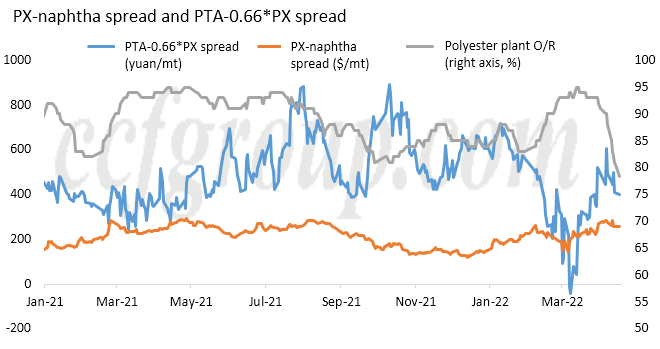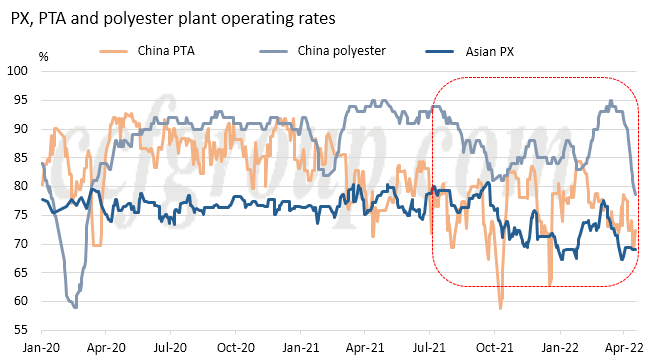PX little affected by polyester production cuts
In Apr, with the adverse impact from the pandemic, weak profits, high inventory as well as logistics restrictions, the operating rate of polyester plants in China declined from 92% in the beginning of the month to as low as 78.8% as of Apr 19. With weakening demand from polyester, participants are focused on any negative impact on feedstock.
PTA market seems to be more hit by downstream polyester production cuts than PX. The margins of PX and PTA have been diverged since Apr. As of Apr 22, PX-naphtha spread has widened by 9.3% from Apr 1 to $295/mt, while PTA-0.66*PX spread narrowed by 16% to 413yuan/mt over the same period.
As the chart shown below, when polyester plant operating rate decreases obviously, PTA-0.66*PX spread squeezes with PTA consumption reducing, while PX margin is cushioned by PTA and thus not so closely related to polyester production cuts.

Besides from the relation among products, the divergence in margins is also caused by PX and PTA operations. PX plant operating rate is currently at its lows in 2 years, with the turnaround season ongoing. In longer time span, it can be seen that PX plant operating rate has dropped obviously since the third quarter of 2021, while polyester and PTA plant operating rates are at their medium levels.

Looking forward, with plant restarting, PX plant operating rate is anticipated to increase obviously in China, but may further edge down with plant maintenance outside China. The average operating rate of Asian PX plants is expected to rise gradually in May. With the expectation that the pandemic situation could get relieved, restrictions could get eased, logistics may recover, and some plants would restart after maintenance, PTA and polyester plant operating rates are also estimated to tick up in May. Both supply and demand for PX are expected to rise.
PX supply and demand could be balanced or supply could increase slightly in China in May-Jun. Regardless of the volatility in feedstock, PX price may keep strong as some PTA plants have restocking requirements, while PX inventory in some plants is low and there’s uncertainty in PX production from some plants. If more PTA plants are shut unexpectedly due to poor economics, PX market would be affected greatly, but any sharp PTA production cuts is unlikely as the industry is greatly concentrated, and upstream and downstream capacity is highly integrated.
- Top keywords
- Cotton Price
- Cotton Futures Price
- Cotton Futures
- CZCE
- PTA Futures Price
- Chemical Fiber
- Polyester Prices
- Wool price
- PTA Futures
- Shengze Silk
- China
- Yarn Price
- price
- China Textile City
- Fibre Price
- Benzene Price
- Cotton
- Index
- Cotton Index
- PTA
- fabric price
- NYMEX
- Top 10
- textile industry
- Spot Cotton
- Cotton Yarn
- Polyester Price
- Futures
- PTA Price
- cotton yarn price

